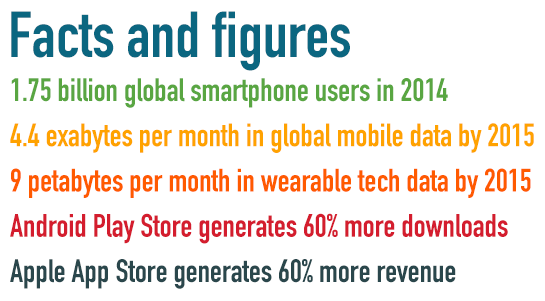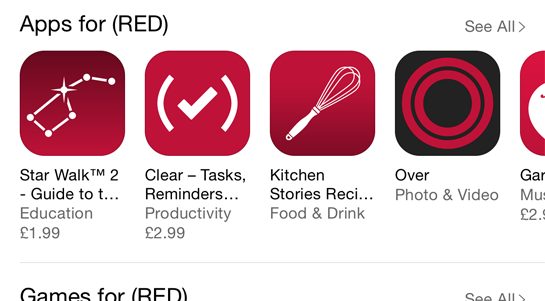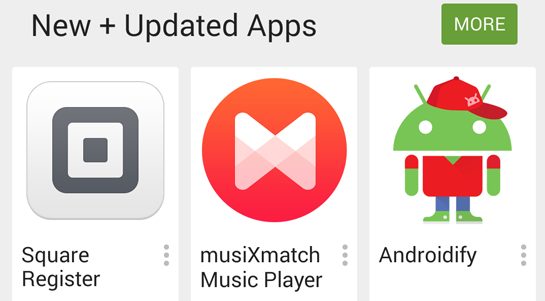News and Insights
App Store Optimistion: An Introduction to ASO
November 21, 2014
With the never-ending rise of the smartphone, people are now engaging with technology and information in ways not available at the start of the millenium.
As more people choose their phone as their primary digital device and many parts of the world skip desktops and laptops and go straight to smartphones and tablets, the consumption of mobile data has grown exponentially.
Apps have been one of the major success stories of the mobile-era.
In short, these are no different to your desktop computer program, but are designed and developed to work specifically on mobile devices. And while many people have a small selection of programs on their computers, typically users install many more mobile apps.
- A recent report from Yahoo Aviate showed that Android users typically install 95 apps on their phones.
- And to further cement their popularity, a recent article from Quartz states that apps account for 52% of all digital media consumption in the USA.
For anyone looking to enter into the app market (or already part of it), they should be aware that the market is highly saturated and many apps do not make money nor are they downloaded. Very few apps can claim to be success stories (although not all apps set out to be).
However, if you do wish to make your app a success, optimising it to rank higher in its respective app store has become an important marketing strategy. App Store Optimisation (ASO) has increased in popularity in recent years.
What is ASO?
ASO is the optimisation of your app information to help it rank higher in the app store search engine. With so many apps available and quite limited search depth from users, ranking highly can make all the difference between downloads and purchases or wallowing in the well of apps that are never downloaded (and you’ll have quite a bit of company down there).
As with traditional SEO, ASO is typically broken into two areas – optimisation of the app itself, and then optimisation of auxillary content (for apps this includes reviews and ratings).
Why is ASO important?
Apps represent a weird dichotomy. They are extremely popular, but so few are actually used and even fewer are downloaded.
Recent data from comscore showed that over 65% of people didn’t download any apps in a given month and only 11% downloaded 4 or more apps in a month.
Additionally, 42% of time spent on apps is spent on a single app that that person uses. Whilst apps are undoubtedly popular, getting people to download and then use yours is extremely challenging.
ASO can help. By helping your app to rank higher in the store you give yourself the best possible chance to get downloads and then its up to the app itself to be good enough for repeat usage.
Guide to App Store ASO
The App Store, launched by Apple in 2008 is one of the most important places to post your app. Aside from the technical differences of developing an app for iOS and for Android, it’s nonetheless important to get your app in both the App Store and the Play Store (Android’s app store).
Android represents an 83% global market share for smartphone operating systems thanks to its popularity across multiple manufacturers (Samsung, LG, HTC and Sony all use Android). Android is also popular for entry-level handsets meaning price isn’t a barrier like it may be with Apple iOS.
Collectively, Gartner predicts that two stores will be responsible for 90% of app downloads by 2017.
So ASO for the App Store and the Play Store is extremely important.
Key areas for Apple App Store optimisation
The key areas for the Apple App Store optimisation are:
- Title
- Recommened to be a maximum of 25 characters to avoid getting shortened, make sure your title is descriptive and also include keywords if you can.
- Description
- Try to keep it short yet descriptive.
- Category
- Be sure to select whether it is a game or an application.
- Keywords
- This allows you to help rank for very specific phrases. Try to make them as relevant as possible but also reflect the keywords you want to rank for
- Reviews
- These are very important for ASO, and as with ecommerce, can be a significant decision maker. A range of glowing reviews in the app store can lead to a significant increase in downloads. You may want to develop a user review strategy and how to encourage people to review your app.
- Ratings
- It goes without saying that having strong ratings can have a positive effect on your download rates.
You also need to think about your app logo and the screenshots you are going to install. This is your opportunity to highlight the visuals and user experience of your app. Without these you may find that people do not download your app, even if you rank highly.
Key areas for Android Play Store optimisation
The key areas for the Android Play Store optimisation are:
- Title
- Try to keep this as short as possible
- Description
- You have 4,000 characters to describe your app – not a huge amount! Make sure it accurately describes your app but also sells your app effectively.
- Category
- Again, select whether it is an application or a game
- Reviews and ratings
- As with the Apple App Store, these are just as important
- Total downloads
- Unlike the Apple App Store, the Play Store shows users how many downloads an app has had (in banded amounts) which can be a good indication of how good an app is (somewhat of the chicken or an egg scenario)
As with the Apple App Store, your app icon and screenshots are really important. But the Android Play Store also gives you the chance to add a YouTube video. As we know, video is the most engaging form of content and as such can make a real difference into how likely someone is to download it.
Also please note that as with all Google products, try not to overly optimise your app – Google actively checks apps that may be keyword stuffing their title, decription and so forth.
Resources
- Statista
- IBTimes
- Golden Gekko
- Search Engine Journal
- KISSmetrics
To learn more about our digital mobile services why not contact us today?
-
TAGS:
- Technology


